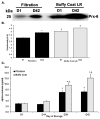A comparison of different methods of red blood cell leukoreduction and additive solutions on the accumulation of neutrophil-priming activity during storage
- PMID: 30171813
- PMCID: PMC6131068
- DOI: 10.1111/trf.14788
A comparison of different methods of red blood cell leukoreduction and additive solutions on the accumulation of neutrophil-priming activity during storage
Abstract
Background: Three methods of leukoreduction (LR) are used worldwide: filtration, buffy coat removal (BCR), and a combination of the previous two methods. Additionally, there are a number of additive solutions (ASs) used to preserve red blood cell (RBC) function throughout storage. During RBC storage, proinflammatory activity accumulates; thus, we hypothesize that both the method of LR and the AS affect the accumulation of proinflammatory activity.
Study design and methods: Ten units of whole blood were drawn from healthy donors, the RBC units were isolated, divided in half by weight, and leukoreduced by: 1) BCR, 2) filtration, or 3) BCR and filtration (combination-LR); stored in bags containing AS-3 per AABB criteria; and sampled weekly. The supernatants were isolated and frozen (-80°C). RBC units drawn from healthy donors into AS-1-, AS-3-, or AS-5-containing bags were also stored and sampled weekly, and the supernatants were isolated and frozen. The supernatants were assayed for neutrophil (PMN)-priming activity and underwent proteomic analyses.
Results: Filtration and combination LR decreased priming activity accumulation versus buffy coat LR, although the accumulation of priming activity was not different during storage. Combination LR increased hemolysis versus filtration via proteomic analysis. Priming activity from AS-3 units was significant later in storage versus AS-1- or AS-5-stored units.
Conclusions: Although both filtration and combination LR decrease the accumulation of proinflammatory activity versus buffy coat LR, combination LR is not more advantageous over filtration, has increased costs, and may cause increased hemolysis. In addition, AS-3 decreases the early accumulation of PMN-priming activity during storage versus AS-1 or AS-5.
© 2018 AABB.
Conflict of interest statement
The authors have no financial conflicts of interest with the submitted manuscript
Figures





Similar articles
-
Prestorage leukoreduction and low-temperature filtration reduce hemolysis of stored red cell concentrates.Transfusion. 2005 Jan;45(1):90-6. doi: 10.1111/j.1537-2995.2005.04061.x. Transfusion. 2005. PMID: 15647023
-
Effects of storage time and leucocyte burden of packed and buffy-coat depleted red blood cell units on red cell storage lesion.Blood Transfus. 2010 Oct;8(4):260-6. doi: 10.2450/2009.0131-09. Blood Transfus. 2010. PMID: 20967167 Free PMC article.
-
Microparticles in stored canine RBC concentrates.Vet Clin Pathol. 2013 Jun;42(2):163-9. doi: 10.1111/vcp.12034. Epub 2013 Apr 5. Vet Clin Pathol. 2013. PMID: 23560818
-
Successful in vivo recovery and extended storage of additive solution (AS)-5 red blood cells after deglycerolization and resuspension in AS-3 for 15 days with an automated closed system.Transfusion. 2007 Apr;47(4):680-6. doi: 10.1111/j.1537-2995.2007.01171.x. Transfusion. 2007. PMID: 17381627
-
Leukoreduction makes a difference: A pair proteomics study of extracellular vesicles in red blood cell units.Transfus Apher Sci. 2021 Jun;60(3):103166. doi: 10.1016/j.transci.2021.103166. Epub 2021 May 21. Transfus Apher Sci. 2021. PMID: 34053881 Review.
Cited by
-
Plasma Transfusion Products and Contamination with Cellular and Associated Pro-Inflammatory Debris.J Am Coll Surg. 2019 Sep;229(3):252-258. doi: 10.1016/j.jamcollsurg.2019.04.017. Epub 2019 Apr 25. J Am Coll Surg. 2019. PMID: 31029763 Free PMC article.
-
Flow-based analysis of cell division identifies highly active populations within plasma products during mixed lymphocyte cultures.Blood Transfus. 2021 Nov;19(6):456-466. doi: 10.2450/2021.0096-21. Epub 2021 Jun 14. Blood Transfus. 2021. PMID: 34369863 Free PMC article.
-
Impact of Different Red Blood Cell Storage Solutions and Conditions on Cell Function and Viability: A Systematic Review.Biomolecules. 2024 Jul 8;14(7):813. doi: 10.3390/biom14070813. Biomolecules. 2024. PMID: 39062526 Free PMC article.
-
Antimicrobial blue light for decontamination of platelets during storage.J Biophotonics. 2020 Jan;13(1):e201960021. doi: 10.1002/jbio.201960021. Epub 2019 Aug 29. J Biophotonics. 2020. PMID: 31407467 Free PMC article.
-
The lysophospholipid-binding molecule CD1D is not required for the alloimmunization response to fresh or stored RBCs in mice despite RBC storage driving alterations in lysophospholipids.Transfusion. 2021 Jul;61(7):2169-2178. doi: 10.1111/trf.16554. Epub 2021 Jun 28. Transfusion. 2021. PMID: 34181769 Free PMC article.
References
-
- Novotny VM, van DR, Witvliet MD, Claas FH, Brand A. Occurrence of allogeneic HLA and non-HLA antibodies after transfusion of prestorage filtered platelets and red blood cells: a prospective study. Blood. 1995 Apr 1;85(7):1736–41. - PubMed
-
- Khan SY, Kelher MR, Heal JM, Blumberg N, Boshkov LK, Phipps R, Gettings KF, McLaughlin NJ, Silliman CC. Soluble CD40 ligand accumulates in stored blood components, primes neutrophils through CD40, and is a potential cofactor in the development of transfusion-related acute lung injury. Blood. 2006 Oct 1;108(7):2455–62. - PMC - PubMed
-
- Fisher M, Chapman JR, Ting A, Morris PJ. Alloimmunisation to HLA antigens following transfusion with leucocyte-poor and purified platelet suspensions. Vox Sang. 1985;49(5):331–5. - PubMed
Publication types
MeSH terms
Substances
Grants and funding
LinkOut - more resources
Full Text Sources
Other Literature Sources
Research Materials
Miscellaneous

